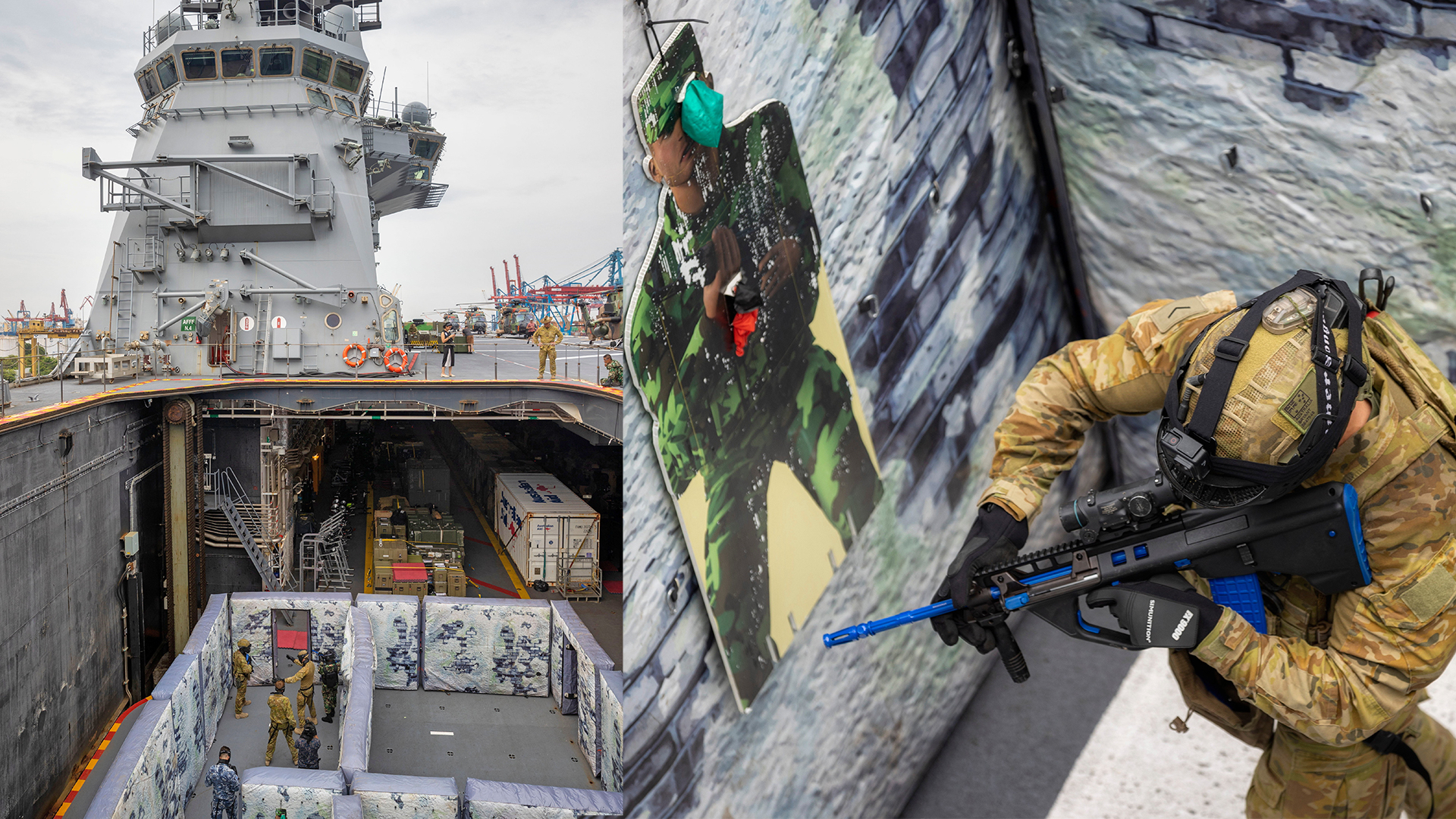Australian Army and Indonesian National Armed Forces soldiers recently conducted a joint training exercise in a pretty interesting location. As images released by the Australian Department of Defense show, an inflatable ‘shoot house‘ (also known as a ‘kill house’) was temporarily constructed on the lowered aircraft elevator of HMAS Adelaide (L01), a Royal Australian Navy (RAN) Canberra-class Amphibious Assault Ship (LHD). Here, soldiers conducted what the Australian Department of Defense terms “airsoft urban training.”
The exercise took place on November 25 in Jakarta, Indonesia. HMAS Adelaide was docked in Indonesia’s capital for three days in total, from November 23 to 26, as part of Indo-Pacific Endeavour 2022 (IPE22). This is one of Australia’s key regional engagement activities designed to strengthen its military partnerships while bringing stability to the Indo-Pacific region. IPE22 is one of a number of exercises this year where Australian military forces have aimed to fulfill both these objectives.
Although the official photo captions don’t explicitly say what kind of drills the soldiers conducted beyond “urban training,” the photos indicate they engaged in various close-quarters combat drills.
After receiving an initial brief ahead of the exercise, we see Australian and Indonesian soldiers take to the improvised shoot house. Equipped with protective vests and headgear, two personnel enter the shoot house and begin to make their way through the course.
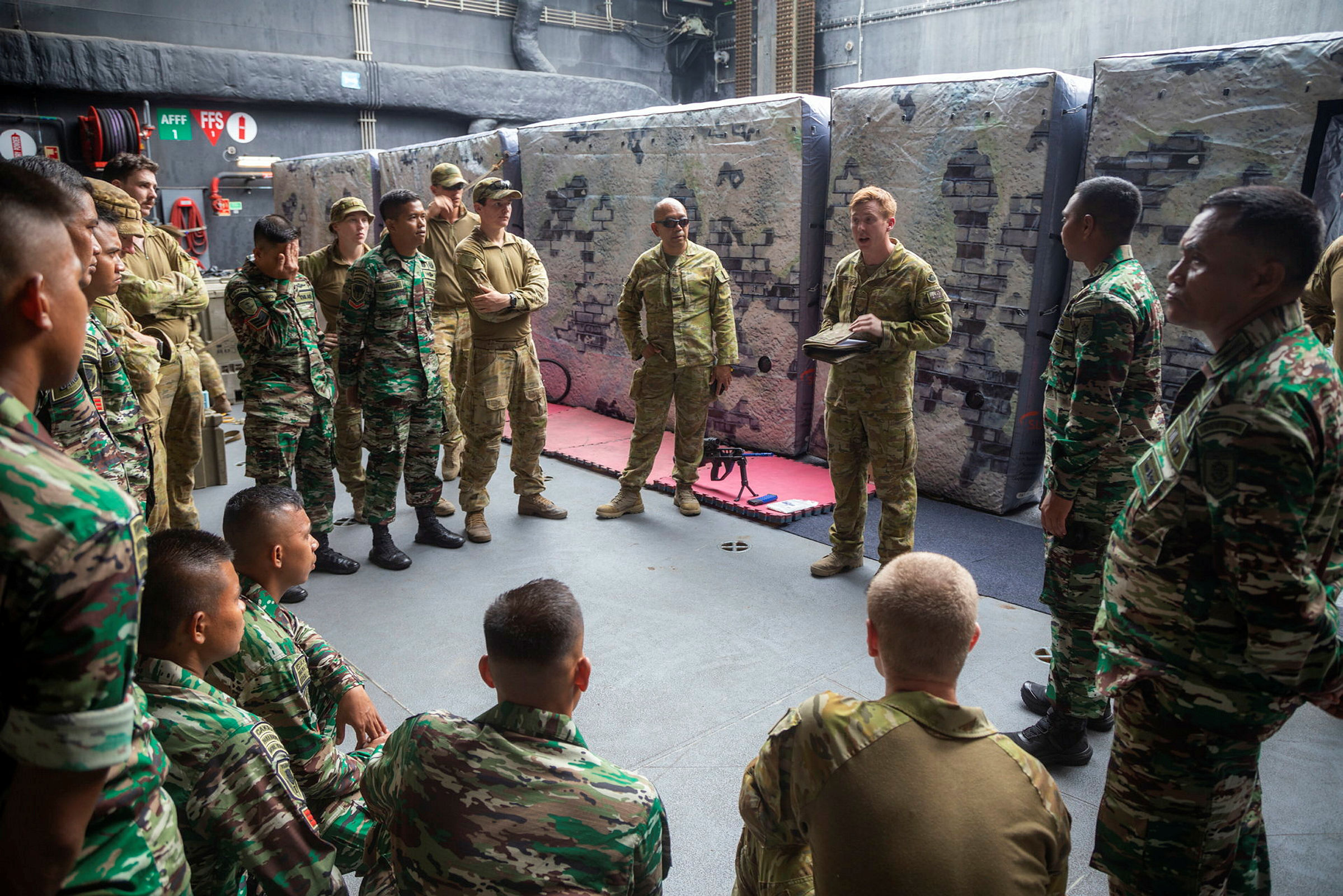
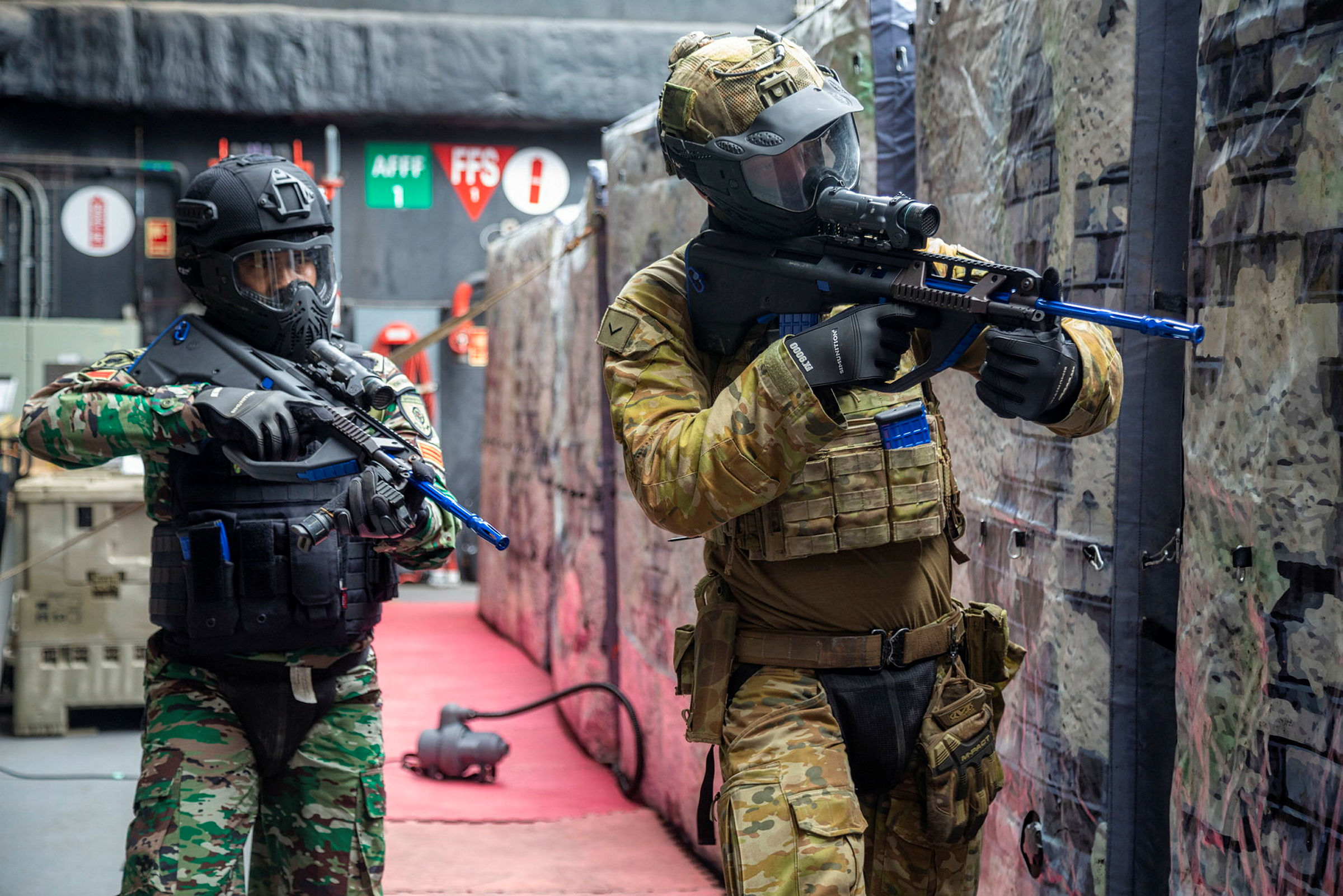
Both soldiers sport F90 rifle training conversions, which feature distinct blue barrels and magazines. It seems likely that the soldiers pictured used Ultimate Training Munitions’ (UTM) “Blue Bolt” weapons converter. By replacing live bolts with the “Blue Bolt,” standard service weapons can be adapted for safe use in training. According to UTM, its conversions “adapt the host weapon to fire UTM ammunition with the feel and function of ‘live’ ammunition.” The “Blue Bolt” works with a man marker round (MMR) made of aluminum casings and non-toxic marking wax.
The Australian Army has used UTM’s “Blue Bolt” conversion during training in the past, as the video below indicates.
Targets can be seen fixed to the shoot house’s inflatable walls. What appear to be balloons are attached to the heads and chests of the targets, which give the soldiers an indication of when targets were positively ‘hit’. Although it’s not immediately clear if the targets were meant to represent specific soldiers, the camouflage pattern seen on their caps appears to resemble ‘Type 99’ used by China’s People’s Liberation Army (PLA).
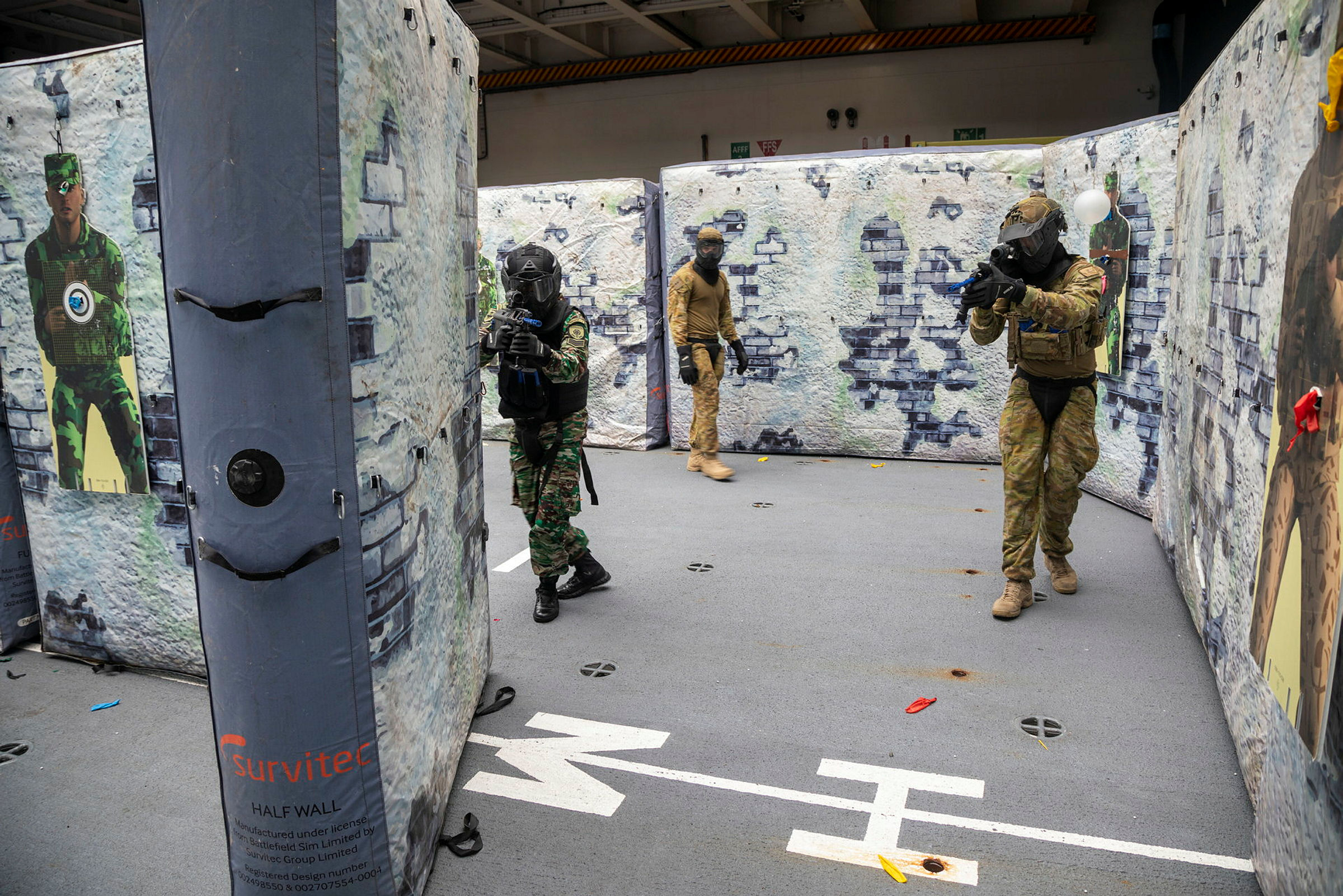
From the official photos, it seems that the inflatable shoot house was provided by survival technology company Survitec (the company’s logo can be seen embossed on the wall’s edge in the image above). According to Survitec’s website, its products provide the “infrastructure required to teach, train and practice urban Close Quarter Battle (CQB) skills and drills.” It would also appear that a variation of Survitec’s “Level 1” inflatable training system (its smallest inflatable training course) was used in the exercise.
A wide-perspective photo of the exercise taking place shows several soldiers engaged in a close-quarters drill below.
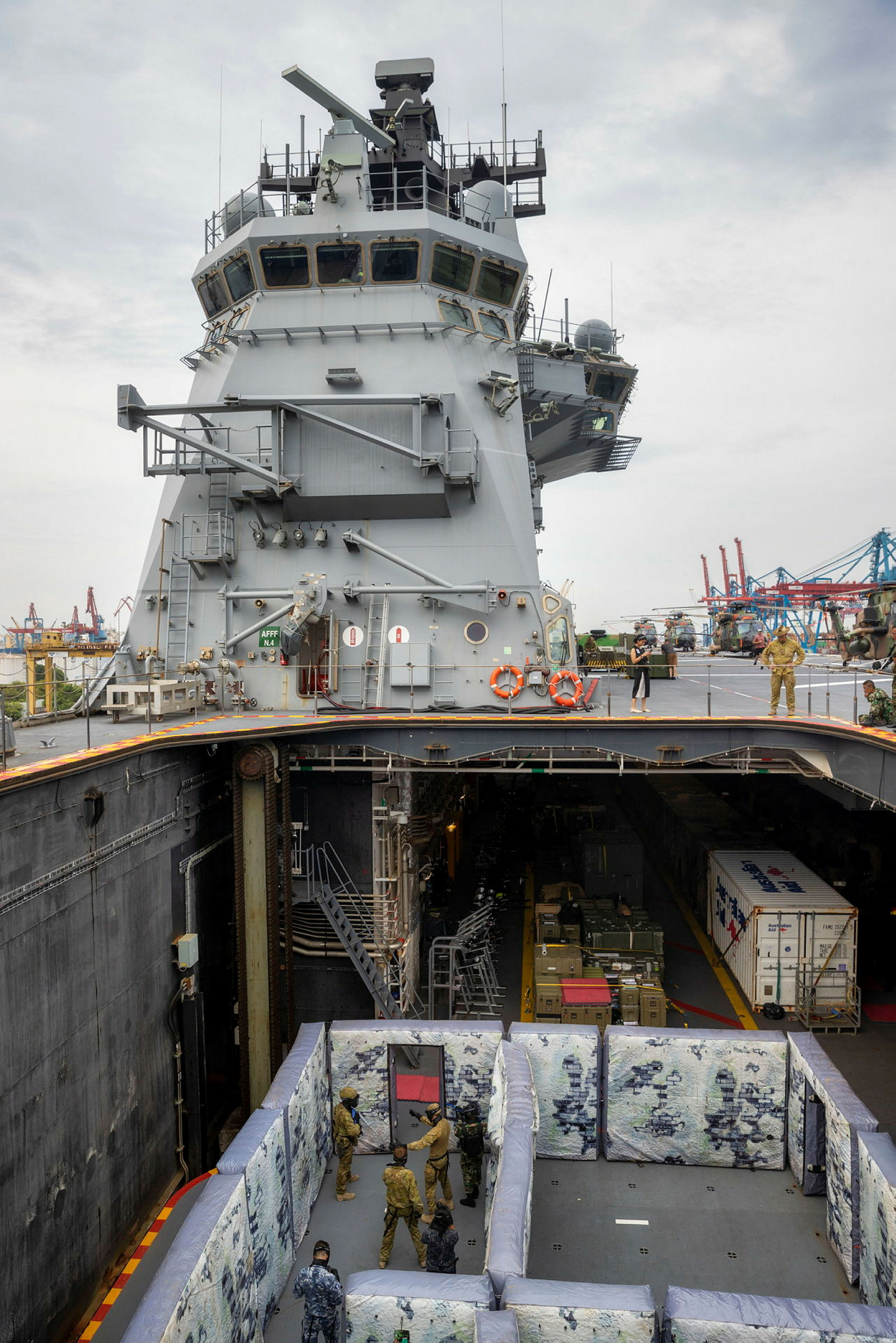
In another photo, an Australian soldier wears what seems to be a GoPro-style head camera, indicating the exercise may have been recorded or live-streamed for fellow soldiers to watch.
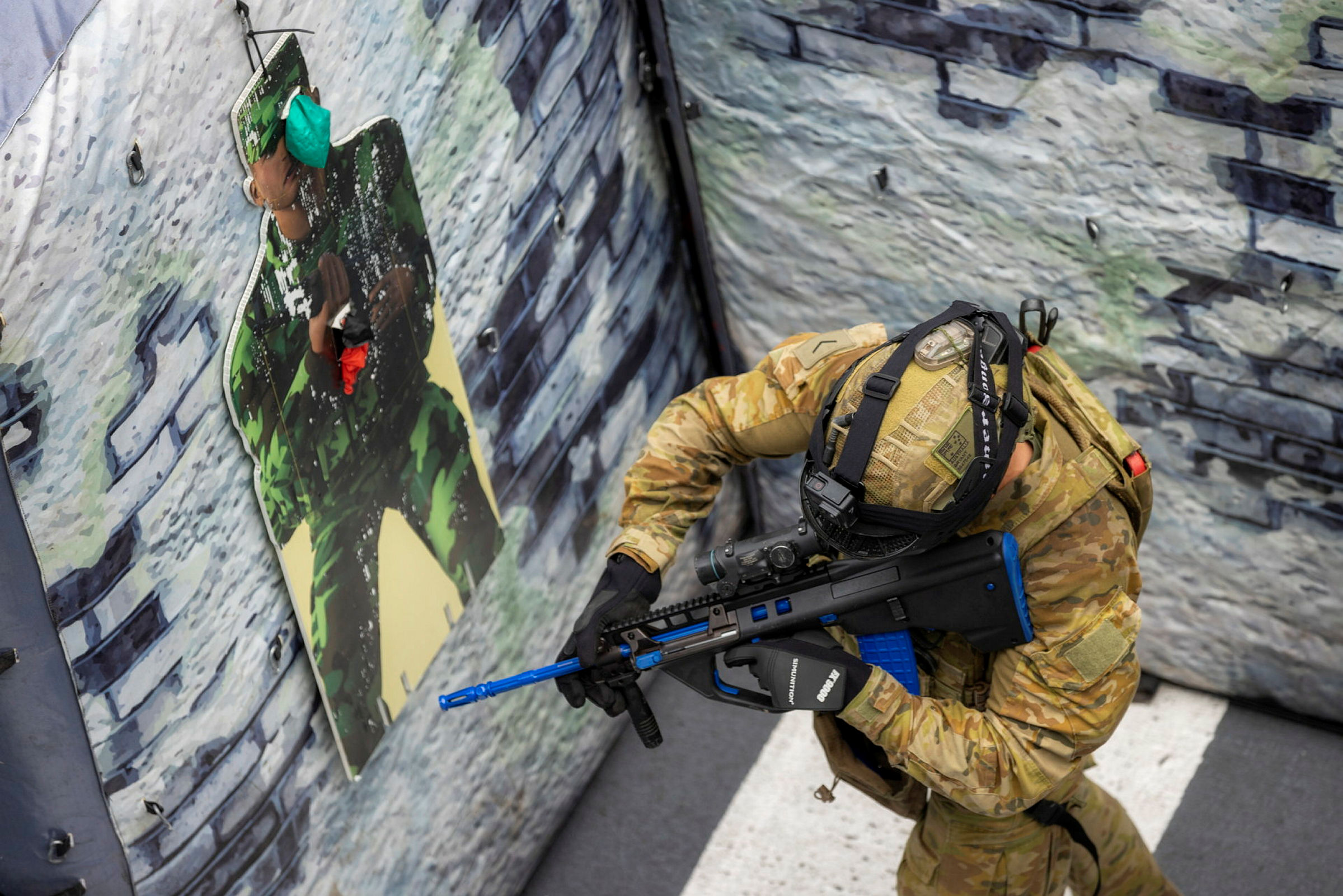
Shoot houses are key training aids for troops and law enforcement preparing for close-quarters battle in urban environments, but are also used aboard vessels and even airliners in anti-terrorism and hostage rescue training. These facilities range from fairly simplistic installations made of plywood, or in this case, inflatables, to very elaborate live-fire ones, including those embedded in full-on military operations in urban terrain (MOUT) installations that can mimic entire towns. They focus on improving every part of a team’s movements, communications, and use of non-lethal munitions, as well as breaching, the identification of friend-or foe (not killing non-combatant targets), and accuracy. Speed of action is obviously another major factor. Check out some shoot houses in operation in the videos below.



Using lowered aircraft elevators on amphibious assault ships for troop training exercises isn’t a new concept. The U.S. Marines use elevators aboard American amphibious assault ships for fast rope training, as you can read about in this past War Zone story.
It should be noted that using this space for close-quarters combat training has a number of advantages. While the exercise aboard HMAS Adelaide was conducted in port, it could also easily be performed at sea – forgoing the need for dedicated training facilities in the execution of this type of exercise. The exercise itself also makes a lot of sense for Australian expeditionary forces, which could easily find themselves dispatched ashore from an amphibious assault ship such as Adelaide to conduct urban close-quarters operations. Depending on the intel available, the inflatable shoot house could, theoretically, be configured to practice maneuvers and role-play scenarios for specific missions. But just being able to keep these perishable skills fresh while at sea is a huge advantage.
Welcoming allied forces aboard Australian naval vessels, and strengthening relationships through joint exercises with neighbors and partners, were key components of IPE22 for Australia. Compared to last year’s engagements, which were restricted due to the impact of the Coronavirus, IPE22 allowed for more interaction between Australian military personnel and their allies.

As Lieutenant General Greg Bilton, Australia’s Chief of Joint Operations, emphasized after IPE22’s conclusion, IPE22 was designed to enhance regional stability in the Indo-Pacific by underscoring inter-allied unity and cooperation:
“IPE22 is a clear demonstration of Australia’s enduring commitment to an open, inclusive and resilient Indo‑Pacific … IPE22 provided a chance for our personnel to build personal links across the region, from meeting senior military commanders to visiting schools and communities. This helped deepen mutual understanding.”
Running for two months from September 26 to November 26, Australian forces visited a record 14 countries in the Indo-Pacific region during IPE22, including the Maldives, Timor-Leste, Vietnam, the Philippines, Bangladesh, Sri Lanka, Laos, Cambodia, India, Thailand, Malaysia, Singapore, Brunei, and Indonesia. The engagements were supported by embarked Australian Army members, an Australian Defence Force Maritime Task Unit of Royal Australian Navy ships, and Royal Australian Air Force air mobility aircraft for fly-in-fly-out engagements. In total, 1800 personnel, five ships, and 11 helicopters were involved. Leaving Jakarta on November 26, Adelaide returned to Darwin in Australia’s northern territory on December 1.
All in all, the close-quarters exercise sought to combine practicable urban warfare training with inter-allied engagement, underlying the aims and purpose of IPE22. Above that, they give us a unique insight into shipboard tactical training capabilities.
Contact the author: oliver@thewarzone.com
